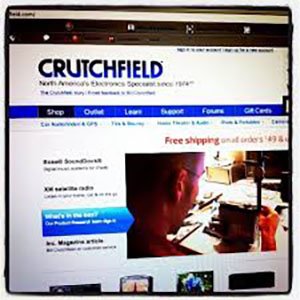Most consumers understand the sales process as complete once money has changed hands and they bring their new box of product home. However, depending on the product, there can be a lot more involved. IKEA has built a global juggernaut on a “you build it” model. But, as anyone who’s perused the five pages of instructions that accompany an entire kitchen will attest, there’s a lot more to some products than opening the box and plugging it in.
Following through after the sale
What Crutchfield understands is that their customers don’t really “own” their products once the financial transaction is complete. Crutchfield began as a catalog for after-market car stereo systems, primarily. They’ve grown into most areas of consumer electronics. And while they stare down big names like Best Buy, Walmart, and Target, it’s their commitment to support after cash changes hands that has made them a success and built an extremely loyal following, despite obvious handicaps.
First among the handicaps is that Crutchfield has no brick and mortar locations. It’s a catalog, so there is the inevitable shipping lag. And even then, once the product is delivered, there’s still the matter of installing it into the car – no small task. And so, the entire experience goes beyond the purchase, and Crutchfield has to be committed to “selling” right through installation. And that’s what makes Crutchfield’s support documentation and support structure so vital to their business – it’s central to ensuring that the experience goes smoothly.
The “sales cycle” for the products is now lengthened, and this means more opportunities to win hearts and minds through great content and interaction. For example, their Crutchfield KnowZone™ is like an online crash course in installing electronics gear of all kinds. The KnowZone has a video library, installation guides, and optimization tools.
This kind of comprehensive content addresses the urgent need driven by their DIY products.
Social products = better word of mouth
Fortunately, the very nature of their product lends itself to an extended period of socialization and more opportunities for their customers to spread the word. When the purchase is made, who isn’t going to share with their buddies the news about the new stereo and then invite them over to help install it?
From a pleasant and personalized transaction, through providing easy-to-read-and-follow documentation, and accessibility for follow-up calls, Crutchfield has multiple customer “touchpoints,” and every single one is an opportunity to win the customer’s loyalty.
Threat Assessment
“Too Costly?”
Ongoing communication with your users is a commitment. It takes a lot of interpersonal communication and segmentation. Digital tools can be used to help make the process more automated and routine. However, Crutchfield wins explicitly because of the personal touch.
“Cheaper Competition”
Crutchfield doesn’t always compete all that well on price for individual products. But, they have a better understanding of what it is they really offer, and it is much more than just the car stereo or HDTV. They have a better shot at long-term customer life cycles and word-of-mouth customer acquisition, despite higher sticker prices.
How has it worked?
A March 2011 profile in Inc. of founder Bill Crutchfield’s approach to customer service sums up their performance nicely:
“With annual sales of roughly $250 million and about 500 employees, Crutchfield is barely a blip on the radar screen of big-box retailers like Best Buy, which had sales of more than $49 billion in 2010. But Crutchfield is debt free and has managed to avoid layoffs throughout its 37-year history. The company has a five-star rating from, and it is the only online retailer to win the Circle of Excellence award for 11 consecutive years from, a website that rates the customer service provided by online retailers.”
